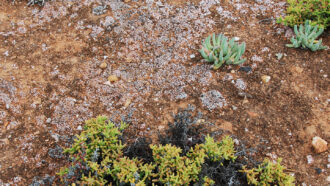
In the unceasing battle against dust, humans possess a deep arsenal of weaponry, from microfiber cloths to feather dusters to vacuum cleaners. But new research suggests that none of that technology can compare to nature’s secret weapon — biological soil crusts.
These biocrusts are thin, cohesive layers of soil, glued together by dirt-dwelling organisms, that often carpet arid landscapes. Though innocuous, researchers now estimate that these rough soil skins prevent around 700 teragrams (30,000 times the mass of the Statue of Liberty) of dust from wafting into the air each year, reducing global dust emissions by a staggering 60 percent. Unless steps are taken to preserve and restore biocrusts, which are threatened by climate change and shifts in land use, the future will be much dustier, ecologist Bettina Weber and colleagues report online May 16 in Nature Geoscience.
Dry-land ecosystems, such as savannas, shrublands and deserts, may appear barren, but they’re providing this important natural service that is often overlooked, says Weber, of the Max Planck Institute for Chemistry in Mainz, Germany. These findings “really call for biocrust conservation.”
Biocrusts cover around 12 percent of the planet’s land surface and are most often found in arid regions. They are constructed by communities of fungi, lichens, cyanobacteria and other microorganisms that live in the topmost millimeters of soil and produce adhesive substances that clump soil particles together. In dry-land ecosystems, biocrusts play an important role in concentrating nutrients such as carbon and nitrogen and also help prevent soil erosion (SN: 4/12/22).
And since most of the world’s dust comes from dry lands, biocrusts are important for keeping dust bound to the ground. Fallen dust can carry nutrients that benefit plants, but it can also reduce water and air quality, hasten glacier melting and reduce river flows. For instance in the Upper Colorado River Basin, researchers found that dust not only decreased snow’s ability to reflect sunlight, but it also shortened the duration of snow cover by weeks, reducing flows of meltwater into the Colorado River by 5 percent. That’s more water than the city of Las Vegas draws in a year, says Matthew Bowker, an ecologist from Northern Arizona University in Flagstaff who wasn’t involved in the new study.
Experiments had already demonstrated that biocrusts strengthened soils against erosion, but Weber and her colleagues were curious how that effect played out on a global scale. So they pulled data from experimental studies that measured wind velocities needed to erode dust from various soil types and calculated how differences in biocrust coverage affected dust generation. They found that the wind velocities needed to erode dust from soils completely shielded by biocrusts were on average 4.8 times greater than the wind velocities need to erode bare soils.
The researchers then incorporated their results, along with data on global biocrust coverage, into a global climate simulation which allowed them to estimate how much dust the world’s biocrusts trapped each year.
“Nobody has really tried to make that calculation globally before,” says Bowker. “Even if their number is off, it shows us that the real number is probably significant.”
Using projections of future climate conditions and data on the conditions biocrusts can tolerate, Weber and her colleagues estimated that by 2070, climate change and land-use shifts may result in biocrust losses of 25 to 40 percent, which would increase global dust emissions by 5 to 15 percent.
Preserving and restoring biocrusts will be key to mitigating soil erosion and dust production in the future, Bowker says. Hopefully, these results will help to whip up more discussions on the impacts of land-use changes on biocrust health, he says. “We need to have those conversations.”

 A new treatment could restore some mobility in people paralyzed by strokes
A new treatment could restore some mobility in people paralyzed by strokes  What has Perseverance found in two years on Mars?
What has Perseverance found in two years on Mars?  This robot automatically tucks its limbs to squeeze through spaces
This robot automatically tucks its limbs to squeeze through spaces  Greta Thunberg’s new book urges the world to take climate action now
Greta Thunberg’s new book urges the world to take climate action now  Glassy eyes may help young crustaceans hide from predators in plain sight
Glassy eyes may help young crustaceans hide from predators in plain sight  A chemical imbalance doesn’t explain depression. So what does?
A chemical imbalance doesn’t explain depression. So what does?